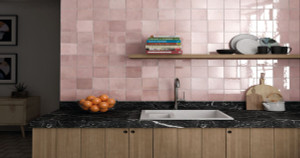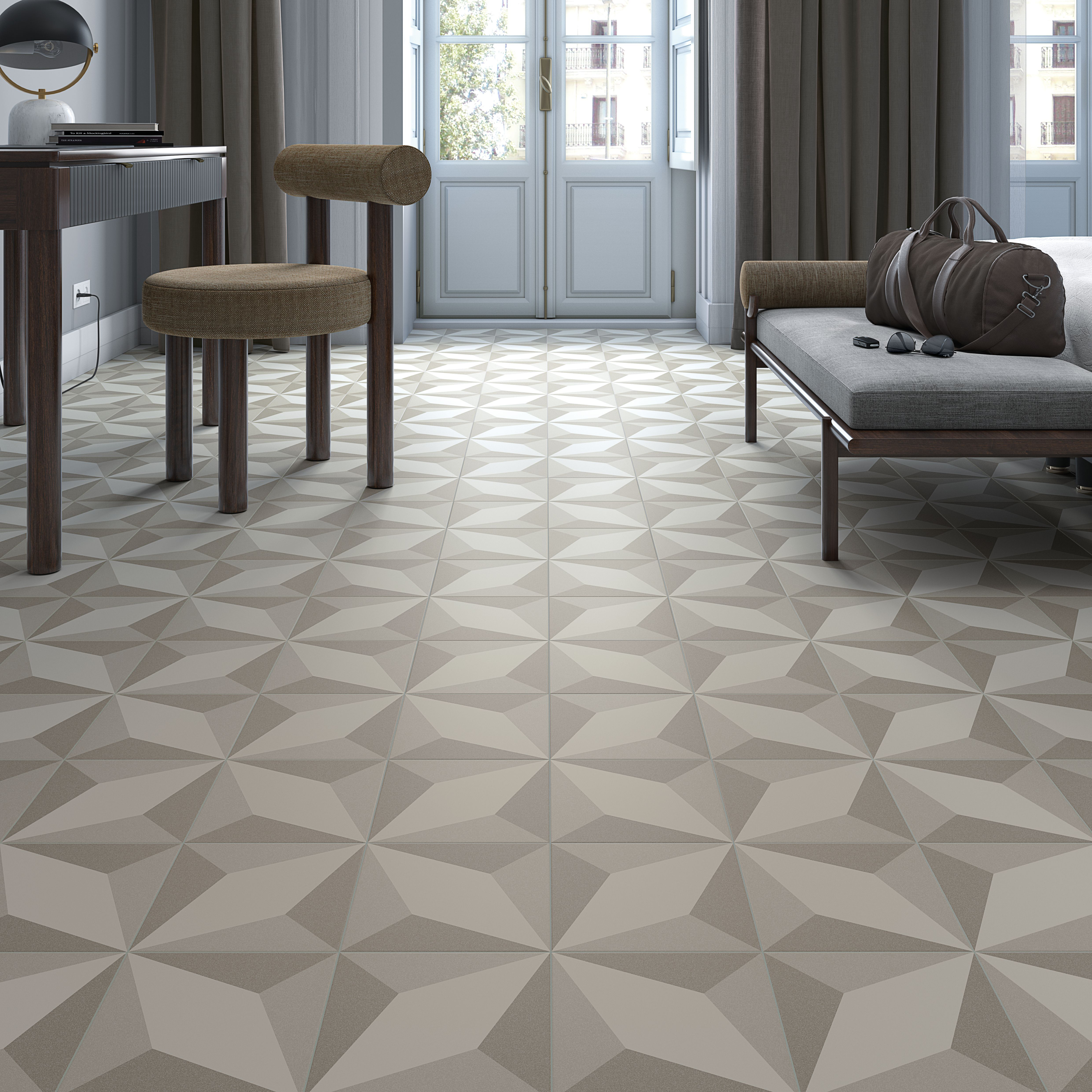19th Aug 2020
All you need to know about tiles
So, you want to buy some tiles. Whether you’re DIYing or just selecting tiles to have professionally installed, it pays to know what you’re looking for when you shop. After all, there are countless types of tiles, each with unique features that you should pay attention to.
Of course, no one has time to learn everything about tiles prior to shopping, so we’ve distilled some of the most important points in this article to help you get informed, empowered and ready to shop.
What are stone-look tiles?

Featured tile: Waterfall Dark Chevron
Stone-look tiles are tiles of any material, usually porcelain or ceramic, that have been made to mimic the appearance of natural materials like stone or marble.
The challenge for stone-look tiles is that, in nature, you expect to see infinite variation. No two pieces of stone look the same, and that’s a large part of the charm of natural stone.
High-quality stone-look tiles are now digitally printed to feature the characteristics and vein patterns found in natural materials. As digital print technology advances, manufacturers are producing tiles with extremely unique patterns and fewer repeats.
Globally, Italian companies put more money towards research, design and production. This results in a tile that is well thought out, has a more accurate design and is an excellent replica of natural materials such as marble or stone.
You should expect high-quality tiles to have many different faces and variations. This means the pattern is less likely to be repeated, making them look more realistic and natural.
What are tile 'faces'?
The number of a tile’s faces refers to how many different patterns are printed on the tiles. This can vary from just 1 on basic tiles to 30+ on premium ranges.
A tile with 20+ faces will look extremely realistic when laid, as it is less likely to have two tiles that look the same in a given space. A tile with fewer faces will repeat the same pattern over and over, and when a pattern is noticeable it will look more artificial.
A high-quality tile will have a degree of variation between the tile faces to make it look more authentic. The below photo on the right shows a tile with just 5 faces and a repeat pattern, in comparison to a tile with 30 faces (left) where the marble looks more realistic.
.


Featured tile: Marvel Calacatta Matt 60 (left) Made in Italy | Absolute Carrara Polish 60 (right) Made in China
Top Tip: Discuss tile faces with your tiler and encourage them to separate matching faces for a more realistic look. A tile with 5 faces can look great if it is well laid.
What does tile variation mean?

Featured tile: Artisan Rose Mallow Gloss
Tile variation refers to the difference in tone, shade and colour between individual tiles. It’s different from tile faces, in that faces refer to a different “print” or design on each tile, whereas variation is concerned with shade and colour.
A low variation tile means there is little difference between each tile and, when the tile is laid, the finished result will look extremely similar to the sample you saw in-store. A good example of a uniform tile would be a white wall tile.
Meanwhile, a high variation tile will deliver the complete opposite look. Each individual tile is different and, when laid together, will show a variety of colours and textures.
To make this clear all our tiles have a V rating from 1 to 4.
V1 – Uniform – minimal differences between pieces of the same production run.
V2 – Slight - clearly distinguishable differences in texture and/or pattern, with similar colours.
V3 – Moderate – the number of colours on each piece vary significantly, but they do not differ greatly between pieces.
V4 – Substantial – random colour differences from tile to tile so that one tile may have totally different colours from another tile.
The Artisan Rose Mallow pictured above is a good example of a tile with a high variation rating of 4. When laying this type of tile, we recommend mixing up the different shades to ensure it looks completely random.
Featured tile: Context White 45.3x75.8
Context White (above) is a stone-look tile with a moderate variation rating of 3. You can see that when laid the individual piece has a lot going on and varies significantly but overall the tiles look similar.
While the difference in variation and tile faces doesn’t determine the quality of the tile, it does have the most impact on how the end result will look. Italians are leading the way with new ideas, they have design teams who study the natural materials for beautiful replicas and are at the forefront of innovative designs.
What’s the difference between a tile’s nominal size and true size?

Featured tile: Waterfall Silver Matt 45x90
When purchasing tiles it is vital you know the "true size" in comparison to the "nominal size".
The nominal size is what you will see in stores and online, this is the expected production size e.g. 600x600, not necessarily the exact size.
The true size refers to the actual measurements of the tile, meaning that a 600x600 tile displayed is, in fact, 598x598 (for example).
This is the result of the manufacturing process, where product sizes vary or machining to a set size takes place. While these variations in size may not seem that important, when it comes to laying your tiles it can have a profound effect on the finished result.
In some cases, you may have chosen a tile to fit an exact space, like a kitchen splashback, without knowing the actual measurements you may end up with a few millimetres gap or too much tile that needs cutting down. Or, you may be mixing tiles with the same nominal size but different true sizes, resulting in the grout joints not lining up between walls & floors.
Top Tip: If you decide to continue your tiles from the floor to the ceiling make sure you check the true size of both of the tiles if you want the lines to match up.
What does “Rectified” and “Cushion Edge” mean in tiles?
There are two types of edges that tiles can have: Cushion Edge or Rectified Edge.
All tiles start out with a cushion edge when they come straight out of the press. The edge is formed in the mould and it will be slightly rounded so that it releases from the mould. Depending on the look required the tiles will either be packed and sold as cushion edge, or they will then be rectified.
Cushion edge tiles will be sorted into matching true sizes (calibrations), normally 5mm+/-. This means the sizes will vary within a calibration by up to 1mm, or more if a larger +/- is used. To allow for this, wider grout joints must be used; 3 to 5mm. The Artisan Colonial Blue tiles below use a wavy cushion edge that creates a more natural look but requirs larger grout joints.

Featured tile: Artisan Colonial Blue Gloss
Rectification is the process of machining the edges, producing a very square edge.
Rectified tiles are machined to an exact size, resulting in one or maybe two calibrations for that tile. The edge is very square, almost sharp, and the size will be precise. There is minimal variation of the tile within its calibration and, due to the exactness of the tile, a smaller grout joint can be used.
When installing rectified tiles it’s important to get them very level. Cushion edge tiles are more forgiving - if there is a slight height difference it’s not very noticeable due to the edges being slightly round and the extra width of the grout joints.
Height differences in rectified tiles can be exacerbated if the surface that they are laid on is not level. The term for this is lippage. With care and proper levelling, lippage can be kept to the minimum if not entirely eliminated.
Top Tip: Talk to your tiler about using a levelling system when installing tiles to ensure the end result is straight and level with no lippage.
What is batch, tone and calibration?
The batch number is the production run that the tile came from. Meanwhile, tone is the colour of the tile and calibration is the thickness and size of the tile.
Batch, tone and calibration all come hand in hand, because there will always be differences in tone and calibration between batches.
More expensive tiles will have smaller differences between batches as they use state of the art technology to reduce the tiny differences in the raw material, humidity and kiln temperature that make it so hard to make one batch exactly the same as another. A bit like baking a cake, it's very hard to make two different cakes on different days and have them be exactly the same.
It is very important to have enough tiles from the same batch for your job, as the differences between batches may be noticable when installed. This is also why we recommend keeping a few leftover tiles, in case you need to do any changes to your space later on.
Do you still have questions? Find your nearest Tile Space store to talk to one of our expert design consultants or check out our Tile Advice page for more tips










































































